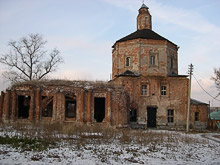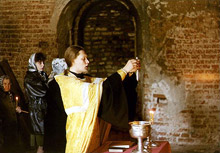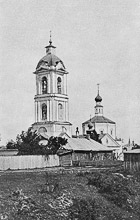|
|
The church of Lord's Purification in Serpukhov
The church of Lord's Purification with the side-altars in the name of Tolgskaya icon of the Blessed Virgin and saint nonsilverers Kosma and Damian in the refectory, built in 1702, is situated in Zanarie, near the Vladychny monastery. The refectory was built in 1813, the bell tower, which changed a hipped bell tower, belonging to the beginning of XVIII century, was built in 1833 (it was destructed during the soviet time). A wooden church in the name of saint nonsilverers Kosma and Damian was situated at this place in old times. It was a centre of Kosmodemiyansky outskirts of town, where the farriers lived.
The architectural view of the church represents the initial stage of the town's stone architecture formation. The common capacity in style "eight on four" with a three-part facetted apse, which is a great rarity, retained from the building of this time. All the altars of Serpukhov's churchs of the first quarter of XVIII century were rebuilt, and we can imagine the view of the important component part of church buildings of the named period only by this beautiful apse.
A large refectory of two side-altars is built in the style of classicism. A rectangular capacity with round corners, decorated with added double Tuscan columns is in its basis. The south and the north facades of the refectory were accomplished by triangle pediments with little cupolas on thin drums. They have disappeared as well as the arch, which crashed down in the middle of 80s.
In 1889 a parish school was opened attached to the church, which was situated in a two-storeyed building, bought by a freeman T.I. Kashtanov.
A firm local legend connects the names of Serpukhov's natives st. Varsonofy, ep. of Tver, wonderworker of Kazan and st. German Alyaskinsky with the church.
Archpriest Alexander Vladychensky who served in the church of Purification was exiled for 3 years and when came back settled alone in the forest in Makarovo district of Kaluga region, where he served for 2-3 years before a new arrest. He was executed on 21 October 1937. Priest Alexander Uspensky who served in the church, choristers Glikerija Petrovna Saveljeva (conventual of Vladychny monastery Larisa) and Tatiana Ivanovna Ryabchenkova were also executed in 1938.
| © Jury Solomatin |
Services and requiems in the church are accomplished every Sunday and on great holidays. The consecration of Easter cakes on Holy Saturday and Great consecration of water on the Holiday of Epiphany is also accomplished.
Clergy: priest Alexiy Spigin — the senior priest.
Address: Moscow region, Serpukhov, Karl Marks Street, 30.
Thoroughfare: From Kursky railway station to st. "Serpukhov", then by bus #5 to station "The Square of 49 Army".
Historical reference
...Looking at the church of Purification (Karl Marks Street, 30), the thought about people's indifference doesn't throw away again. Monument's condition is so bad, that if the measures are not taken, Serpukhov will soon lose one of the best works of local architecture.
The corporal to "the new-built church of Purification and the altar of Kosma and Damian" was given in 1702. Only six years passed since a new cathedral in the name of Holy Trinity was consecrated in Kremlin, and the builder of the church in the name of Lord's Purification was able to renew the graphic order which was taken as a "pattern". And it's not only a coincidence that a new church built by "assiduity of parish" in the first years of XVIII century opened a new page in Serpukhov's architecture. The energization of city life, trade and the appearance of a new circle of customers with new cultural aims played its role. The time when the household way of life but not the high speculation defined the type of spiritual-cultural mentality, came. Besides, the dispute between old and new in art and in life touched deep places of cultural consciousness only marginally. Many things lied at the surface, were solved immediately, were done owing to the cultural custom. Demonstrative devotion of Serpukhov's masters to the antiquity which appeared for the first time in the architecture of the church in the name of Lord's Purification was the reaction to the demonstrability of Peter's changes. This "renascence" is not so much by essence as by form of happening.
...It was created as a result of combining of two different styles. Structural-spacial concept and constructive touch typical for baroque combined with characteristic for XVII century forms of decoration. As a result "naryshkinsky" layerage, trembling movement up were weakened. A bivaulted quadrupling with irregularly put apertures "puts out" a vertical axis. That's why the eight is taken as a part of a unique church's capacity. It is worked up in skillfully painted and carried window aprons, bunches of half-columns with intercepts, a rib and an entablature. A part of decor is hidden with late plaster, but we can see this greatly reserved plastic of facade where the "lively" brickwork is opened.
The original apse of the church in the name of Lord's Purification is a real rarity. The fact is that all the altars of Serpukhov's churchs of the first quarter of the XVIII century were rebuilt in the latest time and we can imagine the view of an important part of religious buildings of the named period only by this beautiful three-part apse. In 1813 a large two-altar refectory in the style of classicism was built at the place of a compact vestibule and a hipped bell-tower that connected with west part of the church in the name of Purification. A rectangular capacity with round corners, decorated with added double Tuscan columns is in its basis. Besides, the south and the north facades of the refectory were accomplished by triangle pediments with little cupolas on thin drums. Now they have disappeared as well as the three-storeyed Empire bell-tower. (1833)
F.V. Razumovsky.
The artistic heritage of Serpukhov's land.
M.: Art, 1992, p. 125-127




